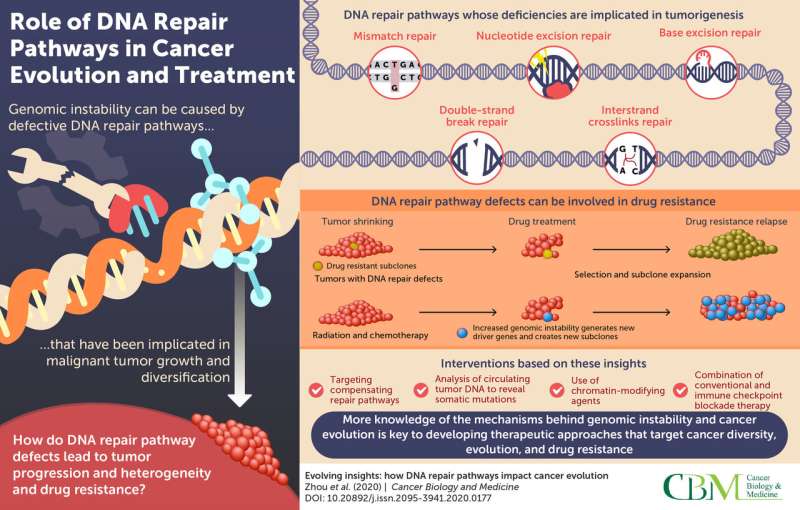Understanding the DNA repair toolkit to chart cancer evolution

The ongoing fight of science against cancer has made great strides, but cancer cells have not made it easy. The complexity of cancer cells and their adaptive evolutionary nature complicate the search for effective cures. Multiple DNA repair pathways in healthy cells typically work to rectify DNA damages caused by sources within the organism, like spontaneous DNA mutations, or from outside, like ultraviolet radiation.
But what happens when these pathways malfunction? It is known that deficiencies in these pathways increase the instability of the genes, and this causes cancer to develop. Therefore, detailed knowledge of how DNA repair pathways participate in this process is crucial for tracking tumor progression, understanding the emergence of drug resistance, and developing efficient therapeutic interventions.
To this end, a group of scientists from China examined five critical DNA repair pathways and their impact on cancer evolution by reviewing the findings of the latest published research. "Different types of DNA damages have corresponding repair pathways to efficiently fix them," says Dr. Jiadong Wang, associated with Peking University Health Science Center and a member of the research team. "So, it is not surprising that particularly defective DNA repair pathways are associated with specific cancers."
They first looked at the mismatch repair system, which eliminates spontaneous mutations to ensure accurate DNA replication. A deficiency in this system, it was found, causes microsatellite instability (MSI), wherein nucleotides, the building-block components of DNA, are either longer or shorter in crucial genes, compared to the normal size, and continue replicating beyond their limit. MSI is clinically associated with 10-15% of colorectal, ovarian, endometrial, and gastric cancers.
Next on their checklist was the nucleotide excision repair (NER) pathway, which recognizes and repairs a wide range of structurally unrelated DNA lesions caused by DNA structural damage. Besides increasing the risk of bladder and breast cancers, an NER deficiency can cause Cockayne syndrome and xeroderma pigmentosum, an ultraviolet light-induced genetic disorder that causes many types of skin cancer.
The base excision repair (BER) pathway, on the other hand, repairs DNA "base lesions" that inhibit cell growth. These lesions are caused by spontaneous DNA decay and external factors like radiation and cytostatic drug treatment. BER pathway components and their deficiency are associated with a high risk of lung, pancreatic, and breast cancers.
Double-strand breaks (DSBs), caused by DNA replication or ionizing radiation, can lead to point mutations, chromosomal rearrangements, and cell death. Two pathways exist to repair DSBs—homologous recombination (HR) and non-homologous end joining. The inactivation of DSB repair genes is closely associated with cancer, and a large fraction of hereditary breast, ovarian, and prostate cancers is caused by BRCA1 and BRCA2 mutations—which are key players in the HR pathway.
Lastly, the scientists discussed the interstrand crosslink (ICL) repair pathway. ICLs, formed from aldehydes and chemotherapy drugs within the body, block essential cellular processes like replication and transcription. They are repaired by the Fanconi anemia (FA) pathway; a defect in this pathway leads to genomic instability, bone marrow failure, and an increased risk of breast and ovarian cancers.
The review combines all these findings, previously scattered across different research papers, and takes them ahead to discuss clinical interventions that could address such pathway damage. Many potential suggestions, ranging from the use of chromatin-modifying agents to the combined application of chemotherapy/radiotherapy with immune checkpoint blockade therapy, have been suggested.
Dr. Ning Zhang, another member of the team, is optimistic that knowing more about DNA repair pathways could be one of the elusive keys to curing cancer. "Specifically, the relationship between DNA repair pathways and cancer evolution need to be explored, because we have seen how closely connected the two are," he says.
Cancer has persisted for so long because of its resilient strategies to live on despite the best efforts of medicine. Perhaps this close look at the role of DNA repair pathways will arm us with another valuable weapon in the fight against cancer.
More information: Evolving insights: how DNA repair pathways impact cancer evolution, Cancer Biology & Medicine, DOI: 10.20892/j.issn.2095-3941.2020.0177


















